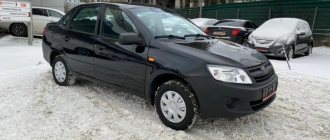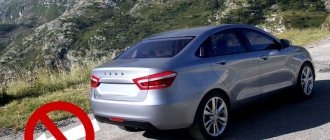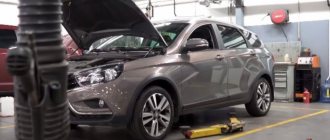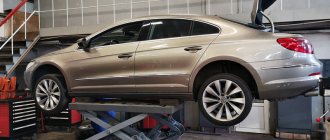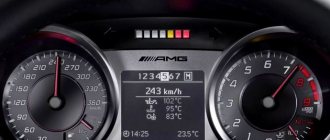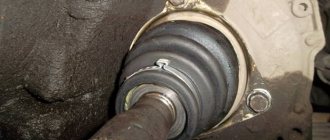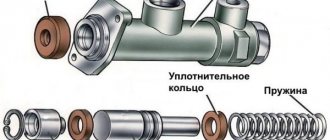Diagnosing a car yourself does not always give good results. Often it is simply impossible to find a complex problem without using the services of a service station. But there are situations when there is simply no time or opportunity to go to the service, and the cause of the problem must be found. This will help make sure that the car can be driven further without compromising the safety of the trip. A knock when starting off can be either a simple problem that can be solved on your own, or a serious problem with a lot of unpleasant consequences. Among the main reasons for such a knock are CV joints, gearboxes, loose wheel mounts and engine mounts. But this is not a complete list of possible problems with knocking in the engine compartment area.
Sometimes it happens that it is impossible to detect a knock from inside the car. You have to drive the car into a pit or overpass and examine all the details in the lower part of the engine compartment. Additional diagnostics of the chassis will not interfere with identifying the problem. First of all, you should check all kinds of fastenings. For example, a loose generator mount can easily cause a knocking noise when starting off or changing gears. A serious problem will be wheel bolts that are not fully tightened. In this case, you can break the entire chassis and lose a wheel while driving.
Engine Troubleshooting
After first jacking up the engine, the old, broken cushions are unscrewed. New ones are installed in their place.
Now, if the engine is misfiring, you must first determine what the reason is. This occurs due to a bad armor wire, a defective spark plug, or wear of one contact in the breaker-distributor. In the case of an injection engine, the injector may become clogged. You can determine which cylinder is not working in a simple way - by removing the armor wire from the spark plug one by one and listening to the engine reaction. If the engine starts to work even more irregularly, then this cylinder is in order. If, after removing the armored wire, it did not react in any way, then this particular cylinder is not working. Now, having identified the non-working cylinder, you can begin to find the cause of its failure and eliminate this problem.
Let's sum it up
Above we talked about the main places where knocking can occur when you press the accelerator.
Since identifying the cause is quite difficult due to the large number of places where it can appear, you should start checking from the smaller ones.
First, check the interior and doors, then inspect the condition of the suspension and steering mechanism, and then diagnose the condition of the airbags.
It is better to check the transmission and drive last, since this may require removing them from the car.
Even if most of the places being checked are not the cause of the sound, an additional check of them will not hurt and will provide information about the condition of the car’s elements.
Jerking when starting to move
At the moment the movement begins, the limiting case of a jerk—failure—most often occurs.
The most unpleasant sensations are associated precisely with the delay in the engine's response to pressing the accelerator pedal.
Sometimes the engine even stalls.
A jerk occurs at the moment the throttle valve begins to open, when, based on a signal from the throttle position sensor, the ECU determines the moment of transition from idle mode to load mode and must increase the amount of fuel supplied through the injectors.
If the pressure in the fuel line is insufficient (even if the injection duration is increased), there is not enough fuel for a smooth start.
Jerks during acceleration
The cause of jerking during acceleration may be, as in the previous case, insufficient fuel pressure in the fuel line.
The electronic engine control unit, having received a signal from the throttle position sensor about the intensive opening of the throttle at a large angle, strives to maximize the fuel supply, but due to the reduced fuel pressure it is not able to do this.
The reasons for this phenomenon and the method of verification are the same as in the previous case.
Jerks during steady motion
Such jerking is most often caused by a malfunction of the ignition system. Diagnosis and repair are required.
Along the way, you can try the following on your own:
– carefully inspect the engine compartment.
Turn off the ignition and check that the wiring harness connectors are securely attached to the ignition coils.
Start the engine and listen to its operation: the crackling sound when the high voltage breaks down to ground is weak, but distinct.
In complete darkness, the spark during breakdown is clearly visible;
– replace spark plugs regardless of their condition and mileage.
Pay attention to the condition of the spark plugs: if they are abnormal, the engine or its systems may need to be repaired.
A specific cause of jerking during steady motion of a car with an injection engine may be sensor failure
throttle position. Additional symptoms confirming the malfunction of this sensor are:
– uneven operation of the engine at idle;
– reduction in maximum engine power.
The sensor is non-separable and therefore cannot be repaired. If a sensor malfunction is detected, it is replaced as an assembly.
The car accelerates poorly
There are many reasons for the deterioration of dynamics, the main ones can be defined as follows.
1. Engine malfunction: decreased compression in one or more cylinders, leakage of additional air into the engine intake tract.
Coking of the exhaust system or damage to the exhaust gas converter (if the vehicle is equipped with a catalytic converter).
2. Malfunction of the power supply system: clogged injectors and fuel filter, hoses of the fuel supply system. Insufficient fuel pump supply. Use of low quality fuel.
3. Malfunction of the ignition system: failure of the spark plug, breakdown of the high-voltage circuit of the system.
4. Engine management system malfunction: failure of system sensors.
If any sensor fails, the electronic control unit switches to working according to a backup program, allowing you to get to a garage or car service center, but at the same time the power and economic characteristics of the engine are reduced.
Car parts that can make this knocking noise
Let's try to figure out what could cause this phenomenon.
You can immediately discard the option of violating the thermal gaps in the timing belt. These knocking noises usually begin at high speeds, then at medium speeds, until the valves begin to knock at idle.
At the same time, the valves do not respond to pressing the gas pedal, that is, if they knock, they knock regardless of whether the pedal is pressed or not.
Also pay attention to the hydraulic compensators, they can also knock.
Let's start with the most curious reasons.
These can be any cylindrical or round things located in storage boxes, under seats, in the trunk or engine compartment.
For example, the same can of WD-40 can become a headache. For example, this can is under the seat. When it begins to move by inertial force, it rolls along the floor and hits some metal surface.
Also, a foreign object, for example a pebble, may somehow end up in the cabin.
Therefore, when such a nuisance occurs, first of all you need to inspect the interior, put all things out of it and the trunk and check whether the noise has disappeared.
This could also be caused by a loose tank cap or oil filler neck.
Now let's move on to more serious reasons.
The knocking noise may be caused by a damaged door hinge. In this case, it does not fit tightly into the lock and there is some play.
When you press the pedal and accelerate, the door hits the pillar, hence the sound. Therefore, the door hinges, as well as the tightness of its fit, also need to be checked.
There could be worse situations.
Single knocks can also appear due to the suspension.
Here, too, backlash is to blame. It may appear due to worn silent blocks or ball joints.
Checking the suspension for play is relatively simple. The car is placed on the overpass, then a mount is used to check for play by swinging the suspension elements.
Since the suspension connections are quite elastic, it is impossible to swing the levers by hand; this is why a pry bar is needed.
The sound can be made by the tie rod ends, although they seem to have nothing to do with the gas pedal.
But the fact is that the existing play in the tips leads to the fact that the wheel can “float” a little when moving, which causes an impact at the place of play.
Severe wear on the wheel bearing can easily cause a knocking noise.
It's easy to check here. To do this, the front wheel needs to be jacked up.
The first thing you need to do is turn it with force; if you hear any sound from the hub, the bearing is most likely worn out.
Next you need to check the wheel for axial play. To do this, you need to grab the wheel from above and below with your hands and tug; if it moves, the bearing definitely needs to be replaced.
Knocks can also be produced by drive elements.
In some cases, CV joints may make a sound, but this is only when they are slightly worn; severe wear is usually accompanied by a cracking sound when turning.
Worn splines in the drive can also make knocking noises. The culprit, again, is the backlash that forms in the spline joint. When accelerated, it can make an unpleasant sound to the ear.
In many car models, this device is mounted directly opposite the gas pedal through a metal partition.
If the plastic bushing in which the gear rack runs in the steering rack has worn out, then when you press the accelerator pedal sharply, especially on a rough road, a knock will be heard, which is felt on the gas pedal and radiates to your foot.
It all happens like this - the wheel jumps in the holes, vibrations through the steering rods and silent blocks are transmitted to the steering rack, if the bushing is worn out, the gear rack begins to vibrate in it, making a sound. Vibrations are transmitted to the gas pedal, which is attached to the same wall as the steering rack, only on the driver's side.
Of course, the knock will be heard when you turn the steering wheel.
Also pay attention to the tie rod ends of the same name. They must be firmly fixed with special bolts or nuts.
If you forget to do this for this reason, after installing them or after wheel alignment, knocking noises are possible.
Read about all possible problems with the steering rack here.
The problem may also lie in the differential.
Backlash in its gears can easily cause knocking. Here, identifying the cause of extraneous noise is much more difficult, since it will require removing the gearbox, disassembling it and checking its condition.
We are looking for the cause in the engine mount.
One of the most common reasons for a knocking sound when you press the gas pedal while driving is wear on the engine mount.
Over time, the rubber of the cushion “sags” and loses its elasticity. Because of this, the engine can “jump” on it, hitting the body.
On different cars, the cause of third-party sounds may be different airbags. In some cars, the “drawdown” of the lower cushion causes a knock, in others it is the upper one.
Vibrations associated with the clutch
Very often, strong vibration when starting off occurs due to a malfunction with the clutch. This may indicate severe wear on the pressure plate and release bearing. The resource of these elements is about 100 thousand kilometers. Over time, the bearing begins to hum and the disc begins to burn.
As a result, the clutch slips under load because a lot of force is applied to it when starting. It is thanks to the disk that it is possible to move the car from its place. The service life of the element on commercial vehicles is significantly reduced, since they have to start with an additional load. Typically, the clutch life of a GAZelle car is 20,000 km. Malfunctions associated with the clutch release drive (such as a broken cable, wear of the rubber cuffs of the slave or master cylinder, wear of the hose, air in the system) do not allow the clutch to be properly released on the vehicle. It may not turn off at all. As a result, it is difficult to engage first gear. This indicates that the system is airy.
Vibration may occur when turned on. It is not worth driving with such a malfunction. A more common situation is vibration of the car when starting off just after replacing the clutch. In this case, there may be poor tightening of the clutch basket mounting bolts or incorrect alignment of the pressure plate. This prevents the gearbox input shaft from engaging the release plate splines. Such consequences also arise as a result of breakage of the petals of the diaphragm spring or damper elements in the torsional vibration limiter.
Engine
Unfortunately, if the car jerks when starting off, the engine can also cause a similar phenomenon. Moreover, its different systems may be to blame for this. A distinctive feature of engine malfunction is jumps in crankshaft revolutions, which is easy to notice on the tachometer. In this case, the engine may not listen well to the driver: it may not respond to pressing the gas pedal, it may make noise.
Diagnosing what exactly causes jerking is quite difficult. The problem may be in the fuel injection system. For example, if the injectors are clogged, then fuel will flow into one combustion chamber, but not into the other. There may also be disproportionate mixing of fuel with air, which will cause jerking not only when starting from a stop, but also when driving on a flat road.
Assembly Recommendations
Before performing assembly operations, even before disassembling, it is necessary to mark the location of the stabilizer on the car. Remember the number of shims. When reassembling, return all the washers to their places so that the adjustment of the angles of the steering axes of the front wheels is not disrupted.
When installing the support pads, use a metal brush to clean the stabilizer from dust, dirt, sand, and lubricate it with a soap solution. This will make it easier to install the cushions.
The airbags are the most important component in the front suspension. They transmit working forces from the wheels to the body. The stabilizer rotates in them. The cushions keep the entire car stable.
Experienced craftsmen recommend that before installation, wrap the pillows with several layers of PVC insulating tape and tighten the brackets onto them. The service life of the pillows will increase two to three times. The knocking noise when starting and braking will immediately disappear.
Transmission Troubleshooting
The first difficult task is removing the gearbox from the car. Depending on the drive of the vehicle, the work required to remove the transmission varies. Before starting work, be sure to drain the oil from it. On a rear-wheel drive car, first unscrew the cardan, the gearshift lever, and then the gearbox itself is unscrewed from the engine. In the case of a front-wheel drive car, the constant velocity joints are unscrewed and removed, and the shaft connecting the gearshift lever to the gearbox is dismantled. And only then the transmission is unscrewed from the engine and removed.
After disassembling the gearbox, you need to inspect the gears and synchronizers for signs of wear. Damaged and worn parts should be replaced. Upon completion of the work, everything is assembled and installed in its place in the reverse order. Once the gearbox is in place, the ideal option would be to change the oil in it.
Steering Troubleshooting
If the type of mechanism is a screw-nut, then during long-term operation the wear of the rubbing parts increases the gap between the worm and the driven gear. It can be eliminated by tightening the adjusting bolt in the steering gear housing cover and using high-quality lubricant. The main thing is not to overtighten the bolt while tightening. Otherwise, rotation of the steering wheel will be difficult and wear of parts will only increase.
If the type of mechanism is rack-and-pinion, then severe wear increases the gap between the rack and pinion. The malfunction can also be eliminated by tightening the adjusting bolt. However, there are mechanisms where there is no gap adjustment. They are replaced assembled, or disassembled and polished on machines. Poor fastening of the steering linkage supports is caused by poor tightening of the bolts. This is also a breakdown of the bracket or, in rare cases, the spar. Eliminated by tightening the bolts and welding broken parts. What to do if vibration occurs when starting off (VAZ 2101-2109)? Let's take a look below.
Sound of unknown origin
It happens that the cause of the knocking is not related to any of the above-described breakdowns. What to do in this case? Perhaps the problem lies in the cable or poor mounting of the sensor, which knocks, hitting surrounding parts. A similar sound can be observed after a foreign object enters the engine area of the machine. Finding such a problem is difficult, but you can try.
- Carry out a complete diagnosis.
- Determine the most accurate place where the knocking noise comes from when starting off.
- Explore all situations in which sound appears and disappears.
- Try doing the repairs yourself.
If you are lucky, you are saved. Otherwise, you will have to drive until the breakdown manifests itself. Every driver knows: the louder the knock, the faster something will happen. Experience shows that unknown sounds can still come from the chassis. For example, cars with dependent rear suspension may make noise due to the shock absorber mounting bracket being torn from the body. A knock when starting off (VAZ-2110 is no exception) may be associated with a broken stabilizer bracket pin. It is located on the lower arm, in the front suspension area.
A knock when starting off (VAZ is most often subject to this problem) can also be caused by a crack in the lower shock absorber bracket at the point of attachment to the lever. The reason for the knocking sound on the Niva is especially interesting. The first manifestation of extraneous sounds occurs as a result of prolonged and careless operation of the machine. A knocking sound when starting off (Niva is one example) is in most cases associated with body malfunctions. One of the root causes may be the tearing of the transverse arm mounting eyes.
Transmission malfunction
The second possible reason is the checkpoint. But if the gearbox is not completely working, then you can also observe other manifestations besides jerks at the start: difficulty shifting any gear, noise from the unit, etc.
If we are talking about a manual transmission, then repairing it can be inexpensive. It is difficult to replace any gear in such a mechanism, but it is possible, and this is something that specialists at service stations undertake. In case the situation becomes more complicated. Repairing it will be expensive. If the variator in an automatic transmission begins to jerk, then the service station most often offers its complete replacement, since repair in this case is impractical.
It is difficult to diagnose a problem due to which a VAZ car jerks when starting off. This can only be revealed by service station specialists during a detailed inspection of the car and its components.
Assessing the condition of shock absorber struts
The shock absorber itself very rarely makes extraneous sounds. And if this has already happened, therefore, the part is in extremely unsatisfactory condition, and in the future simply cannot be used on the vehicle.
The simplest and most common method of checking shock absorbers is to rock the car from the side where the suspected source of the problem is located. If, at the time of rocking, the car body smoothly takes its original position and there is no extraneous noise, therefore, the shock absorber strut is in good condition. If, after swinging, the shock absorber has difficulty lifting the car body, most likely the level of working fluid or gas in it has significantly decreased. This may be caused by a leak in the seal of its housing. In addition, when braking or coming into contact with road potholes, the faulty element cannot completely dampen body vibrations, as a result of which they are clearly felt in the cabin.
This breakdown will make itself felt with a chirping sound, which will intensify when the engine is running at full speed and decrease when gases are released. The cause may be a weak chain tension or timing belt. If it breaks, the knock will be louder. If this happens, prepare a significant amount of money.
In which cars does a knocking sound most often occur when starting from a stop? 2110 is a domestically produced car, which is often subject to various breakdowns, especially if it is used. An increase in sound is noted when the gearbox is shifted. If you have knowledge of car repairs, then you can solve this problem yourself. You'll have to buy a few more parts and assemble everything correctly. Otherwise, contact a car service center.
Vibration when starting from automatic transmission
In an automatic gearbox, jolts at start occur due to severe wear of the clutches, clutches and planetary gears. It is also a matter of a malfunction of the hydromechanical transmission and electronic control system inside the gearbox or dirty oil channels coming from the pump. This is caused by improper operation and the use of poor quality lubricant.
Heavily worn rubbing parts begin to slip when the gearbox is loaded. Malfunction of the electronic control unit valves prevents the required oil pressure from forming in the system, and during a torque converter malfunction, torque is poorly transmitted from the engine to the gearbox. This is caused by severe play in the shaft bearings, as well as breakage of the petals of the drive and driven gears of the torque converter.
Troubleshooting automatic transmission
Before starting repairs, it is advisable to go to a service station and diagnose the box for errors. Automatic gearbox malfunctions are eliminated by searching for worn and faulty components, then replacing them. It is worth replacing only with high-quality spare parts from original manufacturers. Don't buy cheap analogues. When replacing, you should also pay attention to the bearings. Otherwise, the new part may fail before its time.
Repairs need to be approached comprehensively, especially in the case of an automatic transmission. Here you need to go through all the parts for wear and play, replace all rubber products, such as:
Read more: How to prepare an alkaline solution at home
Upon completion of the repair, the oil in the gearbox should be replaced.
Also, at a service station, carry out diagnostics and reset errors stored in the archive of the electronic control unit. In the future, you should use the gearbox carefully, avoid jerking when starting, do not accelerate the car sharply, and before starting to drive, hold the brake pedal down for about one or two seconds so that the pressure required for the gearbox to operate is generated in the oil system.
Wheel bearings SS20 for VAZ cars
Wheel bearings are subject to extreme loads, especially on Russian roads. To ensure rotation of the car wheel without play, with minimal noise and friction, it is necessary to carefully select wheel bearings. SS20 hub bearings have passed 100% quality control and guarantee car owners confidence in road safety.
Share with your friends
Applicability
- VAZ 2101-2107
- VAZ 2108-2110
- LADA Kalina, Kalina II
- LADA Granta
- LADA Priora
- VAZ 2121, 2131
- VAZ 2123 (Chevrolet Niva)
- Datsun on-Do/mi-DO
Advantages of SS20 hub bearings
- high service life and reliability of the bearing;
- quiet operation;
- long service life;
- ensure easy and silent rotation of the wheels;
- high-quality high-temperature lubricant;
- roller bearings are equipped with lubricant, sealed ball bearings are lubricated during assembly and do not require maintenance;
- low level of mechanical losses in the bearing due to low surface roughness and high dimensional accuracy;
- comprehensive protection against counterfeiting;
- complete installation kit.
Guarantee
- Description
- Buy
The wheel bearing is one of the most heavily loaded suspension elements. Wheel bearings allow wheels to rotate and the vehicle to move as a whole. In addition to the perception of loads directly from the wheel rolling on the road, shock and thermal loads are added. Through the hub bearing, all forces arising in the contact patch between the wheel and the road are transmitted to the suspension.
That is, of the suspension and the car depends on the correct choice of front and rear wheel bearings . The main problem when replacing wheel bearings is the large number of low-quality fakes on the market that last no more than 2-3 thousand km, as well as violation of installation technology and incorrect adjustment of clearances.
Malfunctions of wheel bearings manifest themselves in the form of hum, knocking and play when the car is moving, clicks when starting and stopping. As raceways, rolling elements and cages wear, rolling resistance increases and this is accompanied by increased noise and heating of the bearings.
You can determine the malfunction of the wheel bearings yourself. To do this you need:
- Check ease of rotation. Spin the suspended wheel with a sharp jerk and evaluate the noise level emitted by the bearing during rotation. The wheel run-out time is also estimated.
- Determine the presence of play in the hub bearing. On a suspended wheel, applying a load with your hands in the vertical and horizontal planes, check for swing (play) in the bearing. By applying force along the axis of rotation of the wheel, you can estimate the axial clearance.
SS20 wheel bearings will help you avoid problems with low-quality spare parts. The reliability and durability of SS20 bearings is achieved through:
- accuracy of geometric dimensions in the design and production of a product;
- use of high quality steel;
- achieving the required level of surface roughness;
- use of high-tech equipment.
The manufacturing precision of wheel bearings, surface roughness and rolling elements are the key aspects that influence the level of mechanical losses in the bearing and, ultimately, determine the noise class.
During production, the service life of the hub bearings is checked selectively from the batch before failure on a stand that simulates real loads on the bearing. As part of a comprehensive quality assessment, bearing runout is checked with an assessment of the reduction in speed at two stages from 100% to 70%, and the drop in speed from the initial stage to a complete stop. At the same time, the vibroacoustic parameters of the freewheel bearing are checked.
A whole range of serious checks at all stages of the production process allows us to guarantee the buyer the high quality and reliability of SS20 wheel bearings.
SS20 hub bearings have the SS20 branding and additional protection against counterfeiting, which will provide car owners with confidence and safety on the road, and protect them from possible financial and time losses when using counterfeits.
Front wheel bearings for VAZ 2101-07 and 2121, 2123 are supplied as part of repair kits. The SS20 front hub repair kit contains all the washers, oil seals, rings, nuts, bearings and special high-temperature complex lithium grease for bearings required for replacement.
The high quality of the lubricant ensures a service life of up to 300,000 km in the wheel bearing assembly. The amount of grease is calculated to ensure reliable lubrication of the bearings throughout their entire service life. The operating temperature range of the lubricant is from –40°С to +180°С.
Diagnostic technique
Methodology for diagnosing a car and eliminating the defect notes “Vibration, jerking when starting the car”:
Test drive to confirm the defect. Is the defect confirmed?
- YES - go to step 2:
- NO – no repair work is required.
Checking for the presence of fault codes in the ECM and KURKP. Are there any fault codes?
- YES – eliminate the causes of their occurrence in accordance with the relevant technical specifications, and then proceed to step 1;
- NO – go to step 3.
Are there any comments on the stability of the engine at idle and low speeds?
- YES – eliminate the comment and go to step 1;
- NO – go to step 4.
Are there any leaks of working fluids (oil, coolant) in the gearbox area? Was there a risk of getting caught in the clutch?
- YES – eliminate the causes of their occurrence and go to step 5;
- NO – go to step 6.
see also
Comments 21
On the previous one, the traverse under the engine burst and the car jumped like a frog when starting...
It also sometimes shakes back and forth, but more often in the back.
It was the same bullshit, I changed the clutch, after 3 thousand it also jerked quite a bit, I changed the flywheel, again I drove it for 3 thousand and the same bullshit, I hammered in the bolt and I drive on, it’s an office car, the spare parts are delivered like crap, I’m sinning on the clutch and the flywheel itself. When I installed a different flywheel, my dear fellow turned blue from overheating
Engine fingers knock when accelerating
Any extraneous noise in a car engine should alert the driver. Even if the malfunction does not in any way affect the driving characteristics of the car, its very appearance should make the car owner think about diagnostics.
One problem that is often ignored by drivers is engine knocking. It appears when the car picks up speed, and if you do not pay attention to it, over time serious problems may arise in the operation of the motor. In this case, most often the driver can determine the reason why the engine fingers knock during acceleration, as well as correct the situation, without contacting a service center.
Common Sound Sources
Most malfunctions in cars first manifest themselves in the form of third-party sounds.
Thus, a violation of the timing valve clearance is manifested by a metallic knock from under the hood.
A worn alternator belt often begins to “squeal.”
Wear of rubber suspension elements is accompanied by knocking noise from the wheels, and worn shock absorbers are accompanied by strong knocking noises when driving over uneven surfaces.
In the brake system, calipers or pads can knock; even a loose wheel hitting the hub creates a characteristic sound when moving.
What does knocking fingers mean when accelerating a car?
The very definition of “knock of fingers” does not entirely correctly describe the situation that occurs in the engine when the problem in question occurs. There are no “fingers” knocking in the engine, and the sound itself comes from the impact of the blast wave on the cylinder walls.
During normal engine operation, the air-fuel mixture enters the combustion chamber, and its explosion occurs evenly, starting from the spark plug. In such a situation, the speed with which the blast wave propagates is about 20-30 m/s. If the engine has problems with detonation, that is, an excessively enriched mixture enters it, then it detonates immediately after entering the combustion chamber. The blast wave begins to spread chaotically and collide with the walls of the cylinder at enormous speed, up to 800-900 m/s.
Why is knocking fingers in the engine dangerous?
Fuel combustion elements moving chaotically in the cylinder increase the temperature of the cylinder walls. If the engine operates in this mode, then additional loads will be placed on all its elements. When the driver does not pay attention to the problem, it leads to the following malfunctions:
- Curvature of the cylinder block;
- Damage to the valve or connecting rods;
- Piston deformation.
The longer the knocking of fingers continues while the engine is running, the sooner the need for a major engine overhaul will arise.
Why do engine fingers knock when accelerating?
Accelerating a car is a stressful situation for the engine, especially when it comes to a sharp increase in speed. When pressing the pedal to the floor for a sharp increase in speed, for example, from 1000 to 5000, the driver may hear the fingers knocking in the engine, and this is normal. To quickly gain speed, more fuel is supplied to the engine with the same amount of air, which can lead to detonation.
However, the situation when, during a quiet car start and acceleration, the driver hears fingers tapping, is not considered normal. In such cases, it is necessary to identify the cause of the problem as soon as possible and eliminate it in order to avoid serious engine damage.
The following reasons can be cited why fingers knock during normal engine operation:
Air flow sensor failure. If the air flow sensor does not work correctly, the electronic control unit will receive erroneous information and give the wrong signal;
- The ignition timing is incorrectly set. For this reason, the point of maximum fuel combustion approaches top dead center, which leads to increased cylinder pressure and dangerous detonation;
- Damage to the knock suppression sensor. It is imperative that if there is a knocking sound in the engine, you need to check the knock damping sensor. If you find a problem, replace it;
- Incorrect gasoline. Car manufacturers indicate what kind of gasoline should be poured into the engine. If you use fuel with a lower octane rating than the manufacturer recommends, compression problems will occur. They are also possible if low-quality gasoline was poured into the tank at a gas station.
It is worth noting that the knocking of engine fingers is not always a problem acquired during operation. There are situations where a car comes from the factory with sensors connected incorrectly, which leads to this problem. This situation is especially dangerous because the new engine can be seriously damaged. If you hear knocking noises in the engine, have the problem corrected immediately.
How to prevent this?
The following tips are a little banal, but effective. At a minimum, you need to fill your car with high-quality gasoline with the correct octane number. The instructions for the car must indicate what fuel should be poured into the tank.
This also applies to oil. It is necessary to use only the lubricant recommended by the manufacturer. Taking into account the presence of counterfeit oils on the market and low quality fuel, it is necessary to change oils even more often than the car manufacturer recommends. At a minimum, after 8-9 thousand kilometers the lubricant must be replaced. This will extend the life of the motor.
In general, you need to operate the car carefully. If you put a heavy load on the engine at least once and heat it up to the “red zone” on the thermometer, then problems with the engine can arise constantly. In this case, jerking when starting is far from the worst problem.
Knocking when starting off: causes and solution to the problem
Diagnosing a car yourself does not always give good results. Often it is simply impossible to find a complex problem without using the services of a service station. But there are situations when there is simply no time or opportunity to go to the service, and the cause of the problem must be found. This will help make sure that the car can be driven further without compromising the safety of the trip. A knock when starting off can be either a simple problem that can be solved on your own, or a serious problem with a lot of unpleasant consequences. Among the main reasons for such a knock are CV joints, gearboxes, loose wheel mounts and engine mounts. But this is not a complete list of possible problems with knocking in the engine compartment area.
Sometimes it happens that it is impossible to detect a knock from inside the car. You have to drive the car into a pit or overpass and examine all the details in the lower part of the engine compartment. Additional diagnostics of the chassis will not interfere with identifying the problem. First of all, you should check all kinds of fastenings. For example, a loose generator mount can easily cause a knocking noise when starting off or changing gears. A serious problem will be wheel bolts that are not fully tightened. In this case, you can break the entire chassis and lose a wheel while driving.
Fasteners and bolts - we look at many points regularly
You need to check the tightness of the wheel bolts regularly, because incorrectly tightened bolts can cause a lot of problems. But this is not the only reason for a possible knocking sound when starting off. If knocking sometimes accompanies gear changes, as well as sudden stops and acceleration, you should check the fastening of all parts of the engine compartment, including the engine. Problems can be hidden in quite unexpected places:
- if the fastening is broken, the generator begins to dangle and knock on the surrounding metal, while it does not give a charge;
- the starter and retractor relay may rattle if the fastening bolts are poorly tightened;
- The engine itself, if the mounting pad has burst or failed, may wobble and knock;
- the crankcase protection often causes knocking and cracking noises if one of the fastenings of this unit is torn off;
- a battery without fastening can easily wobble in free space, producing a knocking noise during a sharp start;
- Wheel fastening is a classic problem with such manifestations of a problem; they need to be checked constantly.
Conclusion
The gearbox synchronizer is a mechanism that no modern car with a manual transmission or automatic transmission can do without. Without it, the unit would not only work noisily, but would wear out even faster. In addition, manipulating the gear shift would be somewhat more difficult. Although synchronizers have an impressive service life, sometimes they fail. Accelerated wear of mechanisms is associated with ignoring the oil change regulations, aggressive driving and frequent alternation of fast driving and stopping followed by a sharp start. Fortunately, today you can buy both a new synchronizer and its individual components. Although many craftsmen do not recommend repairing this part, in fact it is repairable. We still suggest that car enthusiasts buy a new synchronizer rather than try to “revive” the old one.
Depending on the nature of the knock, that’s where you need to look for the problem. But let’s look at the main places where a malfunction may occur:
- CV joints and suspension.
The hose is stuck to the support bearing
In order for everything to become clear, it is necessary to dwell on each point separately.
CV joints and suspension
Considering the condition of the roads in some cities, require a thorough diagnosis of the chassis on TO-1
First of all, you should pay attention to the sound that appears when you first turn the wheels or start the power unit. If in the first case, then the problem is definitely in the chassis and diagnostics need to be done.
The causes of characteristic sounds may be the breakdown of the CV joints, the failure of the steering linkage or the wear of the steering rack, and soon the ball joint is worn out and the shock absorber strut is knocking. To determine the problem, it is recommended to drive into a pit or lift and carry out a full diagnosis. As a last resort, tug on everything and determine where the sound is coming from.
When a problem is found, it is necessary to fix it as soon as possible, because if a breakdown occurs on the road, it will be almost impossible to repair it on your own. Then only a tow truck. Diagnostics of the chassis and suspension must be done at every maintenance, and saving, as a rule, will not lead to anything good.
Fasteners
There are repeated cases when the bolts on the exhaust pipe burn out or simply break off (there can be many reasons for this phenomenon), and it rubs against the gearbox or other elements.
This can cause a characteristic knocking sound when starting off. Of course, this is not the only place where problems with fastening may arise, so it is worth stopping by the pit and conducting diagnostics.
Check the tightness of the engine protection to the side members!
Gearbox and automatic transmission
There may also be a problem in the gearbox that causes a characteristic knocking noise. Essentially, there are two reasons why a malfunction occurs:
- The gearbox rubs against the clutch.
- The clutch disc has a high degree of wear.
- Insufficient oil level in the manual transmission.
- Insufficient oil level in the automatic transmission.
All these reasons will entail disassembling the unit to fix the problem.
Power units
Under the hood of the diesel Duster there are 109 horsepower
Engine failure is a scary word for any motorist.
First, you should look for reasons in the alternator belt and pump that could cause the knocking. First of all, these are bearings of parts. They could have fallen off, which is what actually caused the knock.
More details about bearing diagnostics:
The second, more terrible option is a knocking sound inside the power unit. The reasons for this phenomenon could be the following malfunctions:
- Deformation of one or more valves.
- Carbon deposits in combustion chambers.
- Development of the camshaft.
Of course, no one talks about the crankshaft, because if it knocks, the car enthusiast will understand it immediately.
Incorrect timing belt tension can cause a metallic knock in the engine area. To fix the problem, it is necessary to disassemble the gas distribution mechanism and check the belt tension and the condition of the roller.
